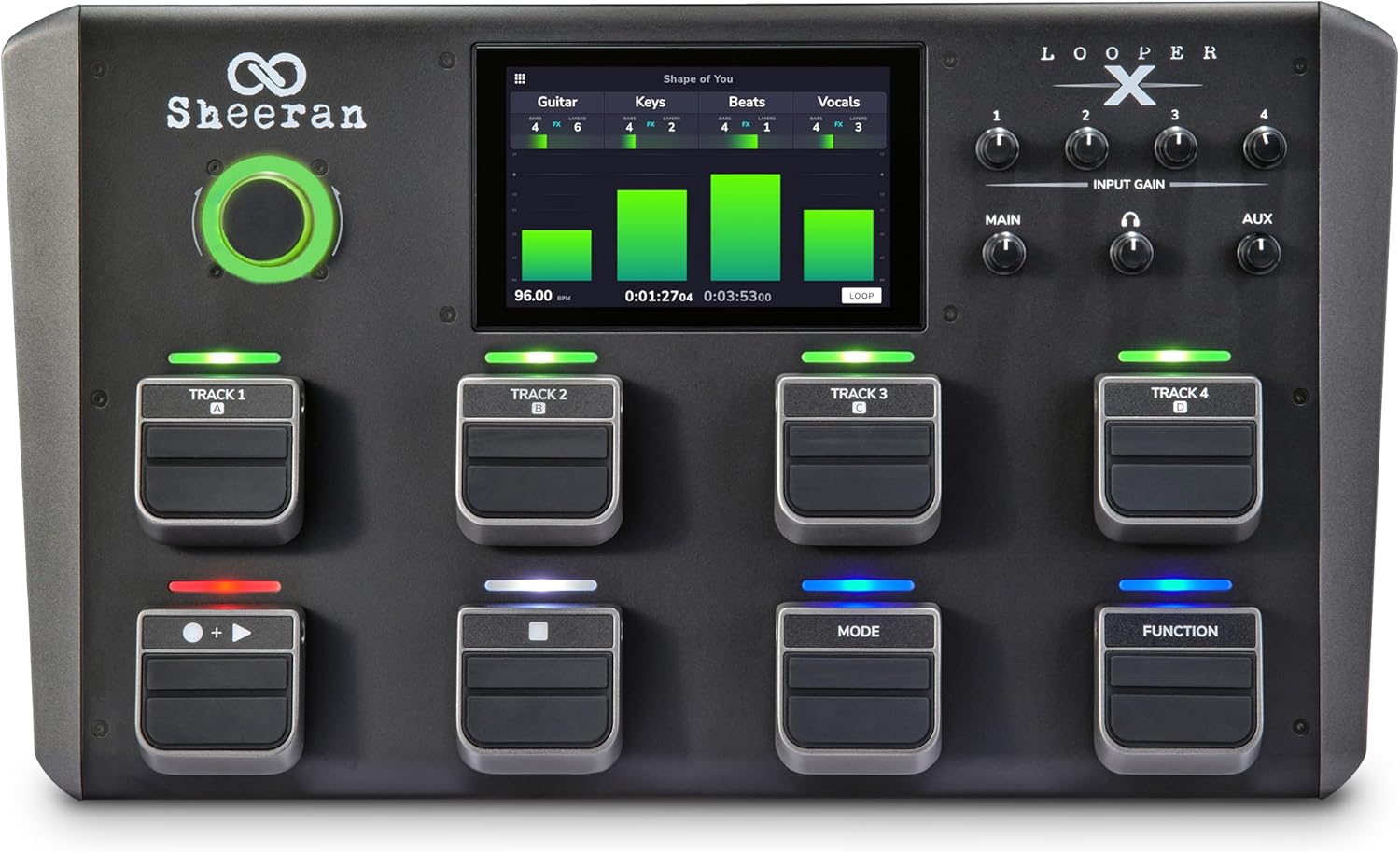Introduction

I don’t actually own one of these, but the User Manual is available online at https://cdn.inmusicbrands.com/sheeran/looper-x/Sheeran%20Looper%20X%20-%20User%20Guide%20-%20v1.0.0.pdf and I’ve been using that to understand how it operates.
As you can see from the image above, the Looper X is basically a four track looper with eight foot pedals arranged in two rows of four.
The top row of pedals are labelled as TRACK 1/A, TRACK 2/B, TRACK 3/C and TRACK 4/D, whilst the bottom row has RECORD+PLAY, STOP, MODE and FUNCTION pedals. The pedals have multiple functions depending on the current mode of the looper. Because of this I’ll also refer to them as Pedals 1-4 (top row) and Pedals 5-8 (bottom row).
The Looper X has five different looping modes based on how the separate tracks are synchronized with each other.
- Multi Mode (4 synchronized tracks locked to the same length),
- Sync Mode (4 synchronized tracks which must be integer multiples or fractions of the primary track),
- Song Mode (4 tracks of potentially different lengths which can be played independently of each other),
- Band Mode (1 track acts as a backing loop, while the other 3 are played independently over the backing loop and must be integer multiples of fractions of the track providing the backing loop),
- Free mode (4 un-synced free-form tracks)
I’ve only tried to emulate the Looper X’s Sync Mode since this seems to be the most naturally aligned mode to how I use Möbius 3.
Be aware that the use of the word mode in the context of looping is distinct from the use of the word mode when referring to pedal behaviour. In subsequent sections where I refer to mode I am almost always referring to pedal behaviour.
Pedal Behaviour:
Normal Mode:
In normal operation the pedals behave as given in the table below.
| Pedal 1 (TRACK 1/A) | Pedal 2 (TRACK 2/B) | Pedal 3 (TRACK 3/C) | Pedal 4 (TRACK 4/D) | |
|---|---|---|---|---|
| Single Press | Select Track | Select Track | Select Track | Select Track |
| Double Press | Solo Track | Solo Track | Solo Track | Solo Track |
| Press and Hold | - | - | - | - |
| Pedal 5 (RECORD+PLAY) | Pedal 6 (STOP) | Pedal 7 (MODE) | Pedal 8 (FUNCTION) | |
|---|---|---|---|---|
| Single Press | Record > Dub > Play | Stop all Tracks | Enter Mute Mode | Enter Function Menu A |
| Double Press | - | - | - | Enter Tap Tempo |
| Press and Hold | Undo last overdubbed layer | Clear all Tracks | Change looping mode | Enter Function Menu B |
- Pressing Pedal 5 starts recording a loop to the selected track if the track is currently empty. If the track is not empty, pressing Pedal 5 will toggle between playing and overdubbing the track. (Record > Dub > Play is the default order but it is possible to change the looper’s setting to make this Record > Play > Dub if preferred.)
Mute Mode:
| Pedal 1 (TRACK 1/A) | Pedal 2 (TRACK 2/B) | Pedal 3 (TRACK 3/C) | Pedal 4 (TRACK 4/D) | |
|---|---|---|---|---|
| Single Press | Mute/Unmute Track | Mute/Unmute Track | Mute/Unmute Track | Mute/Unmute Track |
| Pedal 5 (RECORD+PLAY) | Pedal 6 (STOP) | Pedal 7 (MODE) | Pedal 8 (FUNCTION) | |
|---|---|---|---|---|
| Single Press | - | - | Exit Mute Mode | - |
Tap Tempo:
| Pedal 5 (RECORD+PLAY) | Pedal 6 (STOP) | Pedal 7 (MODE) | Pedal 8 (FUNCTION) | |
|---|---|---|---|---|
| Single Press | - | - | - | Exit Tap Tempo |
| Multi-Tap | Set Tempo | - | - | - |
- Tempo is set based on the time between taps on Pedal 5.